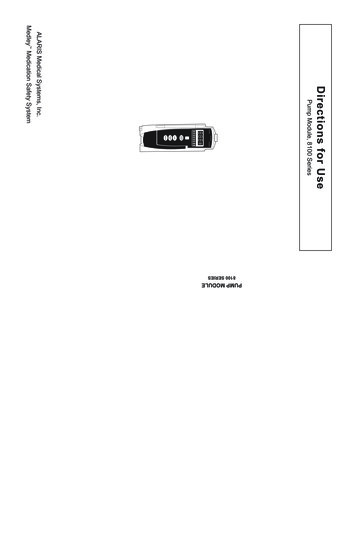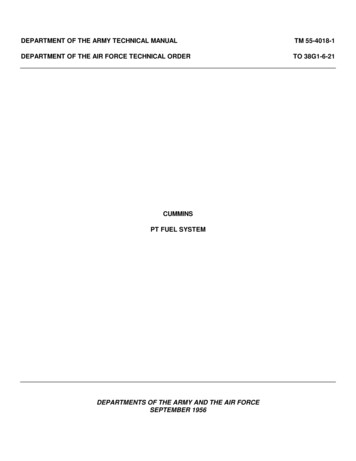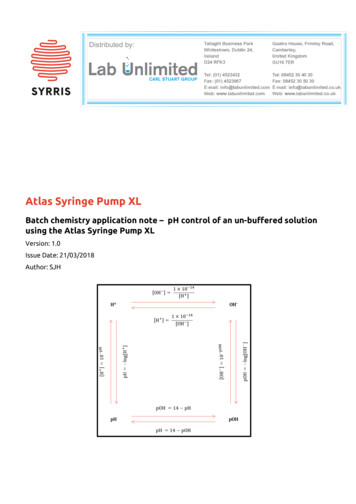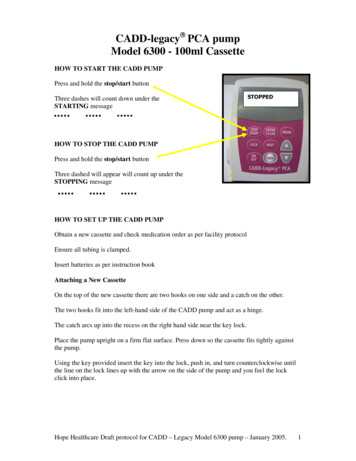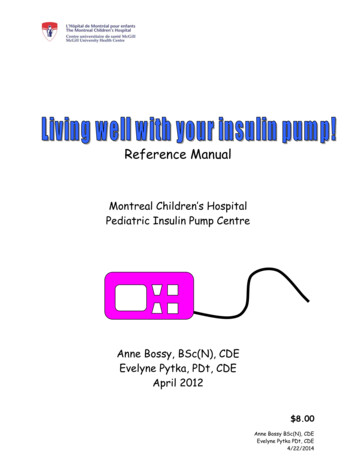
Transcription
Reference ManualMontreal Children’s HospitalPediatric Insulin Pump CentreAnne Bossy, BSc(N), CDEEvelyne Pytka, PDt, CDEApril 2012 8.00Anne Bossy BSc(N), CDEEvelyne Pytka PDt, CDE4/22/2014
TABLE OF CONTENTSPageCorrection Bolus Protocol to Evaluate Basal Rates . .3Check Ketones! . .4Hypoglycemia Protocol for the Insulin Pump . .5Guidelines for Meals and Snacks during Insulin Pump Stabilization . . 6Emergency Kit . . 7Managing Sick Days on a Pump . . 8Guidelines for Temporary Removal of the Insulin Pump . 9Ketones . .11How Can You or Your Child Get Ketones Using the Pump? . . 12Basal Adjustment Guide . 13Testing Basal Rates and Boluses 14Using “Advanced Bolus” Options 15Appendix I: Annual Clinic Visit 18Appendix II: Food Record 19Appendix III: Travel List for Pumpers 20Appendix IV: Managing Activity .21Appendix V: Carb Factors for Various Foods 24Appendix VI: Carb Counting Tips & Tricks when Eating Out . 29Notes . 302Anne Bossy BSc(N), CDEEvelyne Pytka PDt, CDE4/22/2014
Correction bolus protocol to Evaluate Basal Rates:Pump Start (first two or three weeks) & Prior to Clinic VisitsBg 15.0Pre-meal, or overnighttest.No ketonesMealtime – give the bolusas usualBedtime - do nothing.Overnight - give acorrection bolus.Test forketones.2-hr post-mealtestNo correction.No ketone test.Note result in log.Ketones1) Give a correction with asyringe or pen. Use the pumpto calculate the dose (see“Check Ketones”).2) Change the catheter.3Anne Bossy BSc(N), CDEEvelyne Pytka PDt, CDE4/22/2014
Bedtime test : take g carbs containing protein, with no bolus.4Anne Bossy BSc(N), CDEEvelyne Pytka PDt, CDE4/22/2014
5Anne Bossy BSc(N), CDEEvelyne Pytka PDt, CDE4/22/2014
HYPOGLYCEMIA PROTOCOL FOR THE INSULIN PUMPThe 2008 Clinical Practice Guidelines from the Canadian Diabetes Association recommends:MildModerateBlood sugar between3.0 – 4.0 mmolChild is 5 yrs oldBlood sugar is lessthan 3.0 mmolChild is 5 yrs oldGive 20g rapidcarbohydrate.Give 10g rapidcarbohydrate.Give 15g rapidcarbohydrate.GLUCAGONSevereSuspend or disconnect the pump.(convulsion, unconscious, or unresponsive)Always RECHECK the blood sugar 15 minutes after treatment, to verify thatit has risen above 4.0 mmol.There is no need to give a snack afterwards, unless the child is engaged insports or activity.6Anne Bossy BSc(N), CDEEvelyne Pytka PDt, CDE4/22/2014
Guidelines for Meals and Snacks During Insulin Pump StabilizationPurpose: To help adjust basal rates and boluses (carb and correction) as efficiently as possible.During this time, your child should eat three meals and carbohydrate-free ( 3 g), low-calorie snacks(i.e. low in fat, protein and carbohydrate).1. Meals: Please be sure that meals contain known amounts of carbohydrate (use food labels,measuring cups/spoons and a digital scale). Restaurant meals are difficult to calculate precisely,so it is best to eat at home until basal rates and boluses are established.Because large amounts of fat and protein may also affect blood sugars, please avoid thefollowing foods until your child’s basal rates and boluses are established: Pizza Deep-fried foods (e.g. French fries, poutine, etc.) Portions of meat, fish, eggs, cheese, poultry that are larger than usual Chocolate Ice cream Nuts (other than peanut butter on toast or in a sandwich)These foods will be re-introduced once the basic settings of your child’s pump are set.Remember that there is no limit on the amount of carbohydrate at a meal. Please allow your childto eat for his/her appetite and remember that the rules of healthy eating apply to the entirefamily!2. Snacks: Your child may eat snacks that have little or no carbohydrate ( 3 g) and a small amountof protein (1 oz or 30 g of weight, or 7 g protein on the food label) or fat ( 5 g) to avoid anyeffect that these nutrients may have on blood sugars. Any foods that have 30 calories areacceptable.Examples of low carbohydrate/low energy snacks: “light” Jell-O Crystal Light popsicles Tossed salad (lettuce), cucumber, celery or 125 ml (1/2 c) free vegetables (broccoli,cauliflower, zucchini, etc) with 15 mL (1 Tbsp) dip or salad dressing Sugar-free gum Crystal Light or other diet drinks7Anne Bossy BSc(N), CDEEvelyne Pytka PDt, CDE4/22/2014
Pumpers’ Emergency KitMake sure you or your child has access to the following, in case of problems with the pump orcatheter:Infusion setsReservoirsBatteriesAlcohol swabsIV Prep or other brandTegaderm or other brandEmla cream or patchInsulin syringes or pensRapid insulin – at school, keep an unopened vial or cartridge of rapid insulin in a refrigeratorExtra Glucometer and strips (for blood sugar andketones)Glucose tablets or juice** Keep long-acting insulin (N/NPH/Levemir/Lantus) at home in case of pump malfunction or loss(see “Temporary Removal of Pump protocol).8Anne Bossy BSc(N), CDEEvelyne Pytka PDt, CDE4/22/2014
MANAGING SICK DAYS ON A PUMP1. Never omit insulin. Do not disconnect or stop insulin pump unless patient isreceiving insulin by injection.2. Increase frequency of blood glucose and urine ketone monitoring to every 2to 4 hours throughout the entire day and night.3. If hyperglycemia develops during illness, increase the basal rate by 20% to50% for 4 – 6 hour blocks until the illness resolves and blood sugars areback in range.*** for diarrhea, the basals may need to be reduced.4. Adjust boluses to carbohydrates intake. Increase boluses by 20-50% asneeded to return blood sugars to their targets range if elevated aftereating.*** for diarrhea, the bolus may need to be reduced.5. Increase fluid intake as needed to help prevent dehydration and clearketones.6. Examine infusion site as a possible source of occult infection and cause ofhyperglycaemia and ketosis.7. Check pump and infusion device.8. Call the health care team if the patient has persistent nausea or vomitingfor more than 4 hours, if symptoms of diabetic ketoacidosis develop(chest or abdominal pain, deep breathing) or if questions or concerns arise.Starvation ketones: Occur with normal or low blood sugars, usually with “gastro” or “stomach flu”.Are not harmful.Will resolve once the child can eat.Call the Pump Centre or Doctor on call if you need help or support.9Anne Bossy BSc(N), CDEEvelyne Pytka PDt, CDE4/22/2014
Guidelines for Temporary Removal of the Insulin PumpWhy remove your pump?1)2)3)4)the pump is broken and a new one won’t arrive for a few daysthe pump is lost or stolenyou need to be admitted to the hospital and will be unable to operate your pumpyou want to take a “pump break” ( eg. while at the beach)When off the pump, it is best to stick as close as possible to a “basal-bolus” routine. The followingare guidelines only for calculating an insulin dose. Extra blood sugar testing will be neededincluding overnight, to assess how it’s working for you or your child. Please let your doctor or nurseknow when you need to go back on injections, so that we can help you with the “fine-tuning”. Theseguidelines are dependent on your knowing your pump’s settings, ie. basal rates, meal bolus ratio’s,and correction factors (insulin sensitivity factors).ALWAYS KEEP RECORDS OF YOUR CURRENT PUMP SETTINGS. Insulin pumps are machinesthat can break or malfunction. Don’t rely on your doctor or nurse to have all your data upto-date.1) Short term off pump (less than 24 hrs): Rapid-acting insulin (Novorapid or Humalog) willneed to be given approximately every 3 – 4 hours.Combine: 3 - 4 hours of basal insulin a pre-meal bolus for carbs a correction bolus if neededExample: AT 8AM – the blood sugar reading is 14.8- breakfast is 40 grams- carb ratio is 1/15g- correction factor (insulin sensitivity factor) is 4.0- the basal rate is 0.60 units/hr until noon 4 hours of basal: 4 X 0.60 2.4 unitsbreakfast food bolus: 40/15 2.7 unitscorrection bolus: 14.8 – 6.0 2.2 units4.0Total dose: 2.4 2.7 2.2 7.3 units, rounded off to 7.010Anne Bossy BSc(N), CDEEvelyne Pytka PDt, CDE4/22/2014
2) Long term off pump (24 hrs or more): There are 3 options – Give long-acting insulin (Lantus or Levemir) as basal, and rapid insulin for boluses Give intermediate-acting insulin (NPH or N) ** call the doctor on-call for this dose Give rapid-acting insulin every 4 hours including overnight, as per the “short term”exampleUsing Lantus or LevemirCalculate the total daily basal amount of insulin and give as a single dose of Lantus or Levemir. Itcan be given as soon as convenient. Then continue every 24 hours thereafter.Note: These insulins cannot be mixed with other insulins in a syringeTake rapid insulin for meal, snack and correction bolusesThe carb ratio’s and correction factors remain the same as for the pumpChildren who are too young to give their own insulin may need to have a parent go to schoolto give the lunchtime dose.Example: the basal rate is 0.50 units from midnight to 6AM, and 0.40 units for the rest of the dayuntil midnight. The total basal is 10.2 units. The dose of Lantus or Levemir will be rounded off to10.0 units, given once every 24 hours until the insulin pump is resumed.Note: Since Lantus and Levemir are basal insulins, you cannot have a basal rate running when yourestart the pump or severe hypoglycemia may result! Restart your basal approximately 18 hours after the last Levemir dose; 22 hours after thelast Lantus dose. If you want to re-start the pump earlier, set the basal rate at 0.00 units/hr until all theLantus or Levemir has worn off.Important things to remember: Extra blood sugar checks will be needed to see how your adjustments are working, especiallyafter the first injection of Lantus or Levemir.Insulin may need to be decreased for activityCheck for ketones when the blood sugar is over 15.0Be sure to double-check all the settings on the pump and the battery before reconnecting.Always keep an unopened vial of long-acting or intermediate-acting insulin at home, and takeit with you when travelling.11Anne Bossy BSc(N), CDEEvelyne Pytka PDt, CDE4/22/2014
KETONESKetone testing should be always be done when you are sick. Ketones should also be testedif the blood sugar is 15.0 mmol or over, even if you feel well. Using a Precision Xtra orNovaMax Plus glucometer is preferable and will give the most precise results, but a urinetest can also be done.If ketones are not present, give your usual correction using your insulin pump,and recheck the blood sugar in 2 hours. If the blood sugar has not started todecrease, check for ketones again and change your catheter and tubing. Giveanother correction and recheck in two hours.If ketones are present,a dose of rapid insulin must be givenimmediately by syringe or insulin pen.Check with your clinic about the dose protocol for ketones, and when youshould contact the Endocrinologist on-call for help.Symptoms of ketones include nausea and vomiting.If someone with diabetes is experiencing these symptoms, a ketone check should be doneimmediately even if the blood sugar is normal.Ketones mean that the body does not have enough insulin. If left untreated,ketones can result in diabetic ketoacidosis (DKA), coma, brain damage, and/ordeath.12Anne Bossy BSc(N), CDEEvelyne Pytka PDt, CDE4/22/2014
HOW CAN YOU OR YOUR CHILD GET KETONES USING THE PUMP?1) A blocked catheter:- make sure to change your catheter every two to three days.- If possible, change your catheter before giving a bolus (meal or correction) andcheck your blood sugar 2 hours later to make sure it’s working.- never do your catheter change just before bed – if it blocks, you might not realize ituntil the next morning when it’s too late.- always check your blood sugars a minimum of 4 times per day!2) Air in the line:- check the tubing for air bubbles regularly.- keep your opened insulin vial at room temperature; this will cause less bubbleformation in the reservoir and tubing.- make sure all connections are appropriately tightened.- don’t forget to PRIME or FILL CANULA after a new catheter insertion.3) Illness:- colds, fever, sore throat, gastro, etc. will often cause ketones.- check for ketones early in order to get treatment started as soon as possible, even ifyour blood sugars are not elevated.- broken bones, sprains, or other physical stressors can bring on ketones too.4) Your insulin has degraded:- it has passed it’s expiry date.- the bottle has been opened more than one month.- it has been exposed to summer heat or winter cold.- The insulin has been in the pump reservoir too long (ie more than a week)5) Human error:- forgetting to give your meal boluses!- leaving the pump disconnected for too long without checking your blood sugar.13Anne Bossy BSc(N), CDEEvelyne Pytka PDt, CDE4/22/2014
BASAL RATE ADJUSTMENT GUIDEI RULES1) Certain factors will affect blood glucose levels and cause unreliable results, so pick the right day toevaluate you or your child’s basals. Make sure that NONE of the following have occurred within the last12 hours:Moderate or intense exercise unless it is part of the daily routine, that is, done EVERY DAY(e.g. recess at school).HypoglycemiaIllnessHigh protein/fat meals (e.g. restaurant meals), or where the carbohydratecontent is unclearAlcoholic beverages2) Basal testing must begin 4 hours after the last bolus, so that only basal insulin is present.3) Begin your basal test only if the glucose is between 5.0 – 9.5 mmol/L.4) Do NOT give any correction boluses during basal checks unless the glucose rises to 15.0 or over. Ifthis occurs, follow the hyperglycemia/ketone protocol and abandon the basal check until another day.5) If hypoglycemia occurs during a basal test, treat the low and stop the test.6) Basal checks should be done at least 3 times over the same period to verify if an observed trend isconsistent.II Overnight basal check schedule: See “RULES”.Eat a regular supper, not too high in fat and protein, and where the carb content is known.Do NOT take a bedtime snack.Test:1)2)3)4)5)Bedtime4 hours after the supper bolus (if this is after bedtime)Midnight3am6amIII Daytime basal check schedules: See “RULES”.Basal Check PeriodLast MealBegin testing every 2 hours (testing period)1Morning---6:00 to 10:00, then eat breakfast2Mid-day (lunch)Bkft at 6:0010:00 to 14:00, then eat lunch3Late afternoon (supper)Lunch at 11:0015:00 to 19:00, then eat supper4EveningSupper at 16:0020:00 to midnightIV How to make your adjustments: Compare the results of your blood sugar tests over the 4 hour basal testing period.A good basal rate will sustain the blood sugar within 1.7 to 2 mmol over the 4 hour testing period.If the readings increase or decrease by more than that amount, adjust the basal rate up or down by0.025 to 0.100 units/hr (depending on age) over that period. Start the new basal at or near the time you began the basal check. Do another basal check over the same period to evaluate your change.Good luck, and call Anne or Evelyne if you need assistance!14Anne Bossy BSc(N), CDEEvelyne Pytka PDt, CDE4/22/2014
Testing Basal Rates and Boluses1. Testing basal ratesIf your child is old enough, skipping or delaying a meal will allow you to determine if the basalrates are adequate. This is the time to allow your child to sleep late. Please continue to testthe blood sugar every 2 hours during this time. A basal rate that is set correctly will allowyour child to sleep in, delay or miss a meal with running the risk of a low or high blood sugar.Children who are unable to delay or skip a meal, may have a low-carbohydrate/low energysnack ( 3 g carbohydrate; 7 g protein; 5 g fat; 30 calories).Please do not try to test basal rates for more than one mealtime per day.2. Testing meal boluses (insulin to carb ratios)Test meal/carb boluses at a meal where the pre-meal blood sugar level is in target (i.e. thereis no correction bolus required). Eat a meal with known carbohydrate quantities. Frozenmeals (e.g. Michelina dinner) work well. Test the blood sugar 2 and 4 hours after the meal.Because ratios can vary at different times of the day, you will need to try this at each meal.A meal bolus should return the blood sugar to target range within 4 hour if the ratio iscorrects.3. Testing correction bolusesThis is best done at a time when there will be no meal or snack within 4 hours, and when basalrates are well established. Correct the high blood sugar using the bolus calculator program inthe pump, or according to correction formula:(Actual blood sugar – target blood sugar) / sensitivity factorTarget blood sugarSensitivity factorA correction bolus should return the blood sugar to target range within 4 hours.15Anne Bossy BSc(N), CDEEvelyne Pytka PDt, CDE4/22/2014
Using “Advanced Bolus” OptionsOnce your basal rates and ratios are established, many pumpers find that certain foodscause unusual blood sugars. This can happen even if you count your carbs correctly.Some foods raise the blood sugar quickly, while others raise it more slowly. If the bloodsugar rises slower than your insulin peaks, this can cause a low blood sugar 1-2 hours afterthe meal, and then a high blood sugar many hours later. These foods are called “slowcarbs.”“Fast carbs” cause the blood sugar to rise faster than your insulin peaks.The graph below shows the differences in blood sugar increase between differentcarbohydrate foods.Blood Sugar Differences of Carb-containing FoodsGlucose100%Mashed potatoWhite bread, rice50%PastaLentilsReference: DiabSurf16Anne Bossy BSc(N), CDEEvelyne Pytka PDt, CDE4/22/2014
Slow carbs1. High fat foods such as pastries, chocolate, pizza, ice cream; fried foods such as frenchfries, poutine.2. Foods that are less processed, less cooked or high in certain fibres (low glycemic index)such as “al dente” pasta, legumes (chick peas, lentils, etc) old-fashioned (not instant) oats.You can control your blood sugars after eating slow carbs by using a combination-typebolus. Depending on the make of pump you are using, this may be called a dual wave,combination, combo or multi-wave bolus.If you notice that some foods cause a low blood sugar 1-2 hours after eating, or veryhigh readings several hours after your meal, you may want to try this type of bolus.A good way to start, is to calculate your bolus for the amount of carbohydrate, and programyour pump to give 50% (half) of this amount immediately, and extending the remaining 50%over 2 hours. Test your blood sugar every 2 hours. Six hours after the start of your bolus (4hours after all the insulin is delivered) your blood sugar should be back in your target.You may need to try different percentages as well as different times to extend thesecond part of your bolus. Keeping good notes will help you and your diabetes team decidewhat works best.17Anne Bossy BSc(N), CDEEvelyne Pytka PDt, CDE4/22/2014
Fast carbs1. Low fat, low fibre, processed foods such as bagels, white rice, breakfast cereals. Thesefoods are often a big problem in the morning, when most people are more “resistant” tothe action of their insulin. These foods cause a very high blood sugar 2 hours after you eatbut your blood sugar may return to target before the next test.You can control your blood sugars after eating fast carbs by using a “super bolus”. Thisbolus is not found in your pump menu.Program a temporary basal rate of 0% for 1 or 2 hours.Give a meal bolus for the CHO grams correction bolus (if needed) the insulin missing fromthe basal rate.Test your blood sugar every 2 hours. Your blood sugar should be back in your target 4 hoursafter the start of your bolus.Example :meal bolus 4 unitsbasal 1.0 units/hTemporary rate 0% X 2 hoursS uper bolus 4 units (2 X 1.0 u of basal) 6 unitsYou may need to try different temporary rates and different lengths of time. Testingevery 2 hours, and keeping good notes will help you and your diabetes team decidewhat works best.18Anne Bossy BSc(N), CDEEvelyne Pytka PDt, CDE4/22/2014
Appendix I: ANNUAL CLINIC VISITWHY: Once per year, we need to update you on new protocols and pump strategies. To accomplish more during your clinic time, and avoid being sent home with moretesting and follow-up for missing information. To take the “guesswork” out of adjusting your child’s insulin.WHAT TO BRING WITH YOU:1. Besides your usual log, at least three days of extra testing following the same scheduleyou used at your child’s pump start:12:00a3:00abreakfast / 2h afterlunch / 2h aftersupper / 2h afterbedtimeFor those 3 days No snacks (if possible). No correction boluses at bedtime or overnight unless blood glucose is 15.0 Please note any exercise. If you choose to download your readings via computer, make sure you send them toyour doctor at least 3 days before your clinic visit.2. A 3-day food record using the form that follows (Appendix II) that includes All foods eaten including non-carbohydrate foods The portion size or amount eaten (weight, mL or pieces) and carbohydrate amountthat you calculate All blood sugar tests, insulin doses and any comments If a low blood sugar occurred, please also include information on the treatmentARRIVE AT 8:30 am FOR THE ANNUAL BLOOD TESTS. Your child may be asked toarrive fasting. He/she may eat after the blood test.MORNING SCHEDULE:1. Blood test (apply Emla at home if necessary).2. Review with the nurse and dietician.3. Clinic visit with your doctor. Expect to be in clinic all morning. You will receive a phone call a few days prior, to remind you of the AnnualVisit.19Anne Bossy BSc(N), CDEEvelyne Pytka PDt, CDE4/22/2014
Please contact the nurse Anne (23084) or nutritionist Evelyne (23085) if youhave questions, or if you wish to reschedule your Annual Review on a nonclinic day.20Anne Bossy BSc(N), CDEEvelyne Pytka PDt, CDE4/22/2014
Appendix II: Bilan alimentaire / Food recordDateDateRepas & heureMeal & uantitéPortion21GlucidesCarbNom/ NameCommentaires (activités, maladie, etc)Comments (activity, illness, etc.)Anne Bossy BSc(N), CDEEvelyne Pytka PDt, CDE4/22/2014
22Anne Bossy BSc(N), CDEEvelyne Pytka PDt, CDE4/22/2014
APPENDIX III :TRAVEL LIST FOR PUMPERS Pack DOUBLE what you think you will need for the length of your vacation. Keep supplies in separate carry-on bags in case one is lost or stolen. Do not pack insulin in a bag that will go into the baggage compartment of the plane, itwill freeze. Never expose your pump to X-rays and other scans. It can be removed safely forabout an hour. Always check your blood sugar before pump removal, and after reattaching. Disconnect any remote devices (meters, glucose sensor, etc.).Pump supplies: Rapid insulin in a small cooler or“Frio” bag. Infusion sets Reservoirs 2 glucometers; strips Batteries (for pump and glucometer) Emla cream Alcohol swabs IV Prep (if used) IV 3000 or Tegaderm transparenttapePump malfunction or lost/stolen: Long-acting insulin (Lantus, Levemir) **refer to “Guidelines for TemporaryRemoval of the Insulin Pump” Insulin syringes or pens Check with your pump rep if you canborrow a spare pump during yourvacation.Hypoglycemia: Glucose tablets Juice boxes Small snacks GlucagonHyperglycemia and/or Illness: Precision Xtra or NovaMax Plusglucometer with ketone strips Ketostix urine dips as back-up Insulin syringes or pens GravolOTHER THINGS TO REMEMBER: Travel letter for CustomsPhone numbers:- your doctor and/or nurse- the on-call service23Anne Bossy BSc(N), CDEEvelyne Pytka PDt, CDE4/22/2014
- your pharmacyAppendix IV – Managing ActivityHow Much Carbohydrate do you need to Prevent Hypoglycemia?General Guidelines and Typical Carbohydrate Requirements for One Hour of DifferentActivitiesNotice -- the more you weigh .the more you need to eat!ActivityBadmintonBaseballBasketball - moderate- vigorousBowlingBicyclingSlow (8 km/h)Moderate (15 km/h)Fast (25 km/h)Dancing -moderate- vigorousDisco dancingGardening/YardworkLightRaking leavesDiggingChopping woodDigging ditchesShoveling snowLawn mowingGolfing with cartGolfing with pull cartHorseback riding – trotHouse cleaningGrams ofCarbohydrateper kg weightper hourIf you weigh :20 kg(45 lbs)45 kg(100 lbs)68 kg(150 lbs)Suggested snacks in grams of 0450.71530450.3615200.2510150.3615200.48203024Anne Bossy BSc(N), CDEEvelyne Pytka PDt, CDE4/22/2014
Mopping floorsScrubbing floors0.3615200.410203025Anne Bossy BSc(N), CDEEvelyne Pytka PDt, CDE4/22/2014
ActivityIce skating – moderateJoggingSlow (8 km/h)Moderate(11 km/h)Fast (14 km/h)Racquetball-singlesRock climbingRoller skatingSkiingDownhillCross countryWaterSoccerSoftballSquashSwimming - slowfastplaying in the g - ShoppingModerate (5 km/h)Fast (7 km/h)Grams ofCarbohydrateper kg weightper hour20 kg(45 lbs)If you weigh :45 kg(100 lbs)68 kg(150 lbs)Suggested snacks in grams of 5200.3615200.6123040References:1) Colberg S. Diabetic Athletes Handbook, Champaign, IL: Human Kinetics, 20092) Scheiner G. Think Like a Pancreas, Cambridge, MA: Da Capo Press, 20043) University of California San Francisco Diabetes Teaching Centre; Snacks for Exercise4) Walsh J, Roberts R. Pumping Insulin, 4th ed. San Diego, CA: Torrey Pines Press, 2006.5) Langley S. Sports Nutrition Workshop, Dietitians of Canada; Montreal, 200926Anne Bossy BSc(N), CDEEvelyne Pytka PDt, CDE4/22/2014
6) Perkins B, Riddell M; Exercise and the insulin pump; Can J Diab 2006;30 (1) 72-79.27Anne Bossy BSc(N), CDEEvelyne Pytka PDt, CDE4/22/2014
ACTIVITÉGLUCIDES SUPPLÉMENTAIRESDÉBIT BASAL TEMPORAIREACTIVITYEXTRA CARBSTEMPORARY BASAL RATE28CHANGEMENT DE BOLUSREPASMEAL BOLUS CHANGEAnne Bossy BSc(N), CDEEvelyne Pytka PDt, CDE4/22/2014
Appendix V : Carb Factors for Various FoodsUsing A Digital Gram Scale And Carb Factors To Calculate Your CarbohydrateWhat is a carb factor?A carb factor represents the amount of carbohydrate found in 1 gram of a food. It correspondsto the amount of carbohydrate that is available to raise the blood glucose, and does not includefibre. This is another way of calculating the carbohydrate in the foods that you eat. Thismethod is especially useful for people interested in more precise carbohydrate calculations, andis better for certain foods that are difficult to measure using a measuring cup.How to use the carb factorTo use the carb factor, you will require a digital gram food scale that can weigh foods in 1 gramincrements. After weighing your portion of a food, you should multiply its weight by the carbfactor for that food to calculate the amount of carbohydrate in your serving.Example:A whole apple weighing 174 gCarb factor 0.11Total carbohydrate in your apple 174 X 0.11 19 gmCalculating the carb factor for your favourite recipesYou may wish to calculate the carb factor for your own recipes. This is especially useful forbreads, cakes and combined dishes such as lasagna.To calculate you carb factor, you will need to add up the total carbohydrate for the entirerecipe using food tables such as the Nutrient Value of Some Common Foods. Remember tosubtract all dietary fibre. Once the food is cooked, you will need to weigh the cooked/bakedproduct.To calculate the carb factor for that food, divide the weight (in grams) into the total grams ofcarbohydrate (total carb total weight). The number should be less than 1. This is the carbfactor for that food. You need only weigh your portion of this food and multiple the weight byits carb factor to calculate the carb content of your serving.Example:Banana bread recipe.Total carbohydrate of all ingredients 347 gTotal weight after baking 630 gCarb factor 347 630 0.5529Anne Bossy BSc(N), CDEEvelyne Pytka PDt, CDE4/22/2014
Carb Factors for Various FoodsBeveragesGrains and CerealsSoft drinksChocolate milkEggnogMilkFruit PunchAlcoholic beveragesBeer, de-alcoholizedLight0.10 Bagel0.10 Bread, crumbs0.14French0.05Italian0.13Pita, whitePita. whole ole wheatWine: sweet0.14 CornstarchCereal, cold, ready-to-eatFlour. Wheat, all-purposeAll Bran0.42 French ToastCheerios, regular0.64 Kasha, (Buckwheat groats)Corn Flakes0.84 MatzoGranola, Harvest Crunch0.68 Muffin, EnglishGrape nuts0.70 Muffins, commercialRaisin Bran0.68 Pancake, buttermilk mixRice Krispies0.85Mix alone,Shredded Wheat0.69PreparedSpecial K0.74 Rice, long or short grain, cookedWildCereals, hot, cooked in waterSpaghetti: plainOatmeal, minute0.10With sauceCream of Wheat, quick0.10 Tortellini, cheeseTortillas, cornWheatBurrito, beefLasagna, vegetarianMeatMacaroni and cheesePie, .690.420.260.200.260.150.300.400.52Prepared dishesPizza, cheese, thin-crustStew, beef and vegetableSalad, coleslawSalad, potatoShepherd’s Pie (with corn; Pâté chinois)300.270.060.110.120.12Anne Bossy BSc(N), CDEEvelyne Pytka PDt, CDE4/22/2014
FruitsApple, cored, seeded, not peeledFresh, wholeApplesauce, unsweetenedApricots: freshCanned, light syrupDried, uncookedBanana, peeledWhole, with peelBlackberry, rawBlueberries, rawCherries, Canned, in waterFresh, sour, wholeFresh, sweet, wholeMaraschinoCranberries, rawSauce, sweetenedDrie
Children who are too young to give their own insulin may need to have a parent go to school to give the lunchtime dose. Example: the basal rate is 0.50 units from midnight to 6AM, and 0.40 units for the rest of the day until midnight. The total basal is 10.2 units. The dose of Lantus or Levemir will be rounded off to


